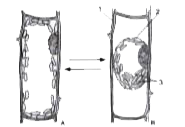In the descending limb of loop of Henle, the filtrate becomes progressively
(a) isotonic
(b) hypotonic
(c) hypertonic
(d) watery
isotomic
hypotonic
hypertonic
watery
To solve the question regarding the changes in the filtrate within the descending limb of the loop of Henle, we can follow these steps:
1. Understanding the Structure: The loop of Henle is a U-shaped structure in the nephron of the kidney, consisting of a descending limb and an ascending limb.
2. Function of the Descending Limb: The descending limb of the loop of Henle is primarily permeable to water but impermeable to solutes (like electrolytes). This means that water can leave the filtrate, but solutes cannot enter or leave.
3. Filtrate Movement: As the filtrate moves down the descending limb, water is reabsorbed into the surrounding interstitial fluid due to the osmotic gradient created by the higher concentration of solutes in the medulla.
4. Concentration Changes: As water leaves the filtrate, the concentration of solutes in the filtrate increases. This results in the filtrate becoming more concentrated or hypertonic compared to the blood plasma.
5. Conclusion: Therefore, as the filtrate progresses down the descending limb of the loop of Henle, it becomes progressively hypertonic.
Final Answer:
(c) hypertonic
---
(c) hypertonic
Topper's Solved these Questions
- EXCRETORY PRODUCTS AND THEIR ELIMINATIONBOOK - ICSECHAPTER - EXCRETORY PRODUCTS AND THEIR ELIMINATIONEXERCISE - REVIEW QUESTIONS (Fill in the blanks: )
14 Videos
- EXCRETORY PRODUCTS AND THEIR ELIMINATIONBOOK - ICSECHAPTER - EXCRETORY PRODUCTS AND THEIR ELIMINATIONEXERCISE - REVIEW QUESTIONS (True/false: )
10 Videos
- ENZYMES BOOK - ICSECHAPTER - ENZYMES EXERCISE - REVIEW QUESTIONS (LONG ANSWER TYPE QUESTIONS)
6 Videos
- KINGDOM FUNGI BOOK - ICSECHAPTER - KINGDOM FUNGI EXERCISE - REVIEW QUESTIONS (LONG ANSWER TYPE QUESTIONS)
5 Videos
Similar Questions
Knowledge Check
The filterate in PCT is
(a) isotonic
(b) hypotonic
(c) hypertonic
(d) wateryAisotonicBhypotonicChypertonicDwateryAssertion: In the descending limb of loop of Henle the urine is hypotonic, while in ascending limb of loop of Henle, the urine is hypertonic.
Reason: Descending limb is impermeable to water while ascending limb is impermeable to Na+AIf both assertion and reason are true and reason is the correct explanation of assertionBif both assertion and reason are true but reason is not the correct explanation of assertion.Cif assertion is true but reason is falseDif both assertion and reason are false.
Assertion : In the descending limb of loop of Henle , the urine is hypertonic , while in ascending limb of loop of Henle , the urine is Hypotonic .
Reason : Descending limb is impermeable to Na' while ascending limb is impermeable to H2O
View SolutionAscending limb and Descending limb of Henle's loop
View SolutionDescending limp of loop of henle is -___ and ascending limb is ____to water
View SolutionAssertion : While on going down the loop of Henle, the filtrate becomes hypotonic.
Reason : The descending limb of loop of Henle is impermeable to both water and electrolytes.
View SolutionAssertion :− The descending limb of loop of Henle is permeable to water but almost impermeable to electrolytes.
Reason :− Henle's loop plays a significant role in the maintenance of high osmolarity of medullary interstitial fluid.
View SolutionIn the given figures 'A' shows a cell in the normal state and 'B' shows the same cell after leaving it in a certain solution for a few minutes :

Was the solution isotonic, hypotonic or hypertonic in which the cell was kept ?
View Solution
